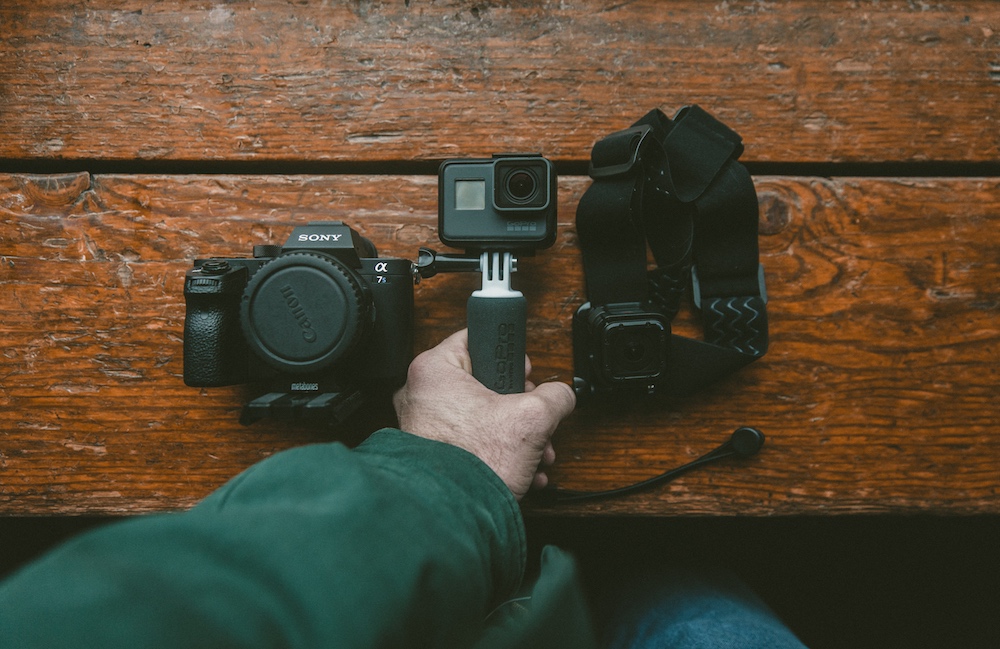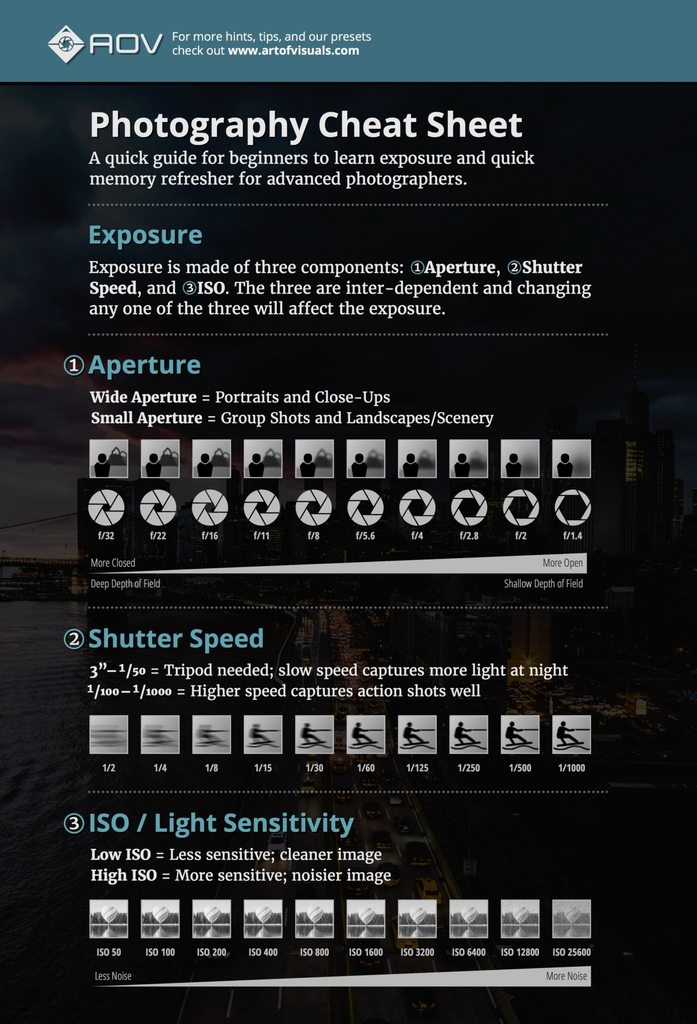
Art of Visuals
The Basics of Photography -
An Introduction to Photography
Hey there, you made it!
Glad to see you found your way to our Basics of Photography series. We have taught the basics of photography to photographers around the world through Art of Visuals, so we know just exactly how difficult it can be to learn the basics principles of photography.
My goal is to make this Basics of Photography series the absolute simplest way to learn the basics of photography in the fastest amount of time possible. I hope you’ll love this series because of what you learn here, and I hope you’ll join the Art of Visuals Academy after you get your feet wet with the Basics of Photography.
Let’s get going.
BASIC EQUIPMENT YOU’LL NEED
You can do photography with even the simplest of cameras, but the principles that I’d like to teach are for people who want to learn to use a DSLR camera, a micro four-thirds camera, or at least a camera that allows the photographer to adjust the shutter speed, aperture, and ISO. For a full list of gear that we recommend, check out our selections on Adorama. Now that you have your camera, let’s jump into learning exposure.
EXPOSURE
When we talk about “exposure,” we simply mean the brightness or darkness of a photo. It seems simple enough to take a photo that is correctly exposed (has the proper brightness or darkness), but in reality, it can be quite tricky. Exposure uses Aperture, Shutter speed, and ISO in conjunction to create a properly exposed image. View, share, and download the infographic below to help better understand exposure below.
Art of Visuals Exposure Cheat Sheet:

WHAT IS APERTURE?
Simply put, Aperture is the hole within your lens, through which light travels into the camera body.
The image above on the left is shot at an aperture of 1.4 making it a wide aperture while the image on the right is taken at 5.6 making it a more narrow aperture, therefore more of the shot is in focus.
WHAT IS ISO?
In very basic terms, ISO is the level of sensitivity of your camera to available light. The lower the ISO number, the less sensitive it is to the light, while a higher ISO number increases the sensitivity of your camera.
Low ISO Image:
High ISO Image:
WHAT IS SHUTTER SPEED?
Shutter speed, also known as “exposure time”, stands for the length of time a camera shutter is open to expose light into the camera sensor. If the shutter speed is fast, it can help to freeze action completely, as seen in the below photos. If the shutter speed is slow, it can create an effect called “motion blur”, where moving objects appear blurred along the direction of the motion which you can also see in the below photo.
Example of a high shutter speed image:
Example of a low shutter speed image:
WHAT IS WHITE BALANCE?
As the name suggests, white balance balances the color temperature in your image. How does it do this? It adds the opposite color to the image in an attempt to bring the color temperature back to neutral. Instead of whites appearing red or yellow, they should appear white after correctly white balancing an image.
Art of Visuals White Balance Cheat Sheet:
AUTO FOCUS MODES AND HOW THEY WORK
DSLR’s come with a range of autofocus modes. For simplicity, will focus on AF-C and AF-S.
Single Focus
One Shot / S-AF / Single Servo / AF-S / S, etc., is the simplest form of autofocus. In general, you press the shutter-release button halfway, or your camera may have a separate AF-ON button, and the camera will lock focus on a subject on which you have placed the active autofocus sensor. Press the shutter button the rest of the way to take the image. The advantage? Simplicity. You aim, the camera focuses, and you shoot. The disadvantage? Did your subject move? Did you move? If the distance between camera and subject changed, that initial focus solution is no longer valid. You will have to go through the process again. If your camera has an “autofocus assist” light on the front, it is likely that you need to be in this mode to get the lamp to illuminate the scene so the camera can focus.
Continuous Focus
Continuous AF / C-AF / AI Servo / AF-C, etc. is where the camera’s electronic brains start to do some pretty cool things to help you keep your subject in focus. In general, the camera locks onto a designated subject, chosen by you using the autofocus point(s), and then tracks that object as it moves in the frame. If the locked subject moves closer or farther, or if you move, the camera will adjust focus accordingly. The advantage? Taming dynamic situations with sports action, moving kids or roaming wildlife. The disadvantage? If you must recompose your image after the focus is locked, your camera may get confused into locking onto another part of your frame.
PHOTOGRAPHY COMPOSITION
So, “composition” describes placement of relative objects and elements in an image. Consequently, the composition is a key aspect of great photography. There is hardly a way to overemphasize the importance of composition. Any aspiring artist ought to give the composition of his work a lot of attention.
Composition Examples:
WHAT IS AN IMAGE SENSOR
The camera sensor size affects many factors in your images and the functions of your camera body. It has a major impact on the quality of your image, how your lens functions, and how it performs in low light conditions. There are three basic size categories for sensors: Four Thirds, APS, and Full Film Format (full frame). Smaller sensors are used in point and shoot cameras while the larger ones are found in DSLR cameras.
METERING AND HOW IT WORKS
MEMORY CARDS
This is what your camera uses to store images and video files from the camera. The faster the memory cards the better the performance for photo and video. We personally shoot with Lexar Memory cards because they are fast and dependable but there are also other great companies out there.
PHOTOGRAPHY LENSES FOR BEGINNERS
In this video below we make recommendations for the best lenses for beginners. You can also visit our gear page on Adorama for our favorite selection of camera lenses and photography gear.












This is amazing. I’am a newbie in photography and thank you for the basic tutorials.
just amazing. Post good
Thank you very much for your photography lessons. Am getting something in brain.
Thank you! Our goal is to create really valuable content for the community. Glad to know we are doing the right things! Best,
Prince
This is wonderfully explained and laid out. Thank you!
thank you for the tips.its helps me a lot.
Thank you for the well structured and useful information for a newbie like me! The only minor issue that I have is that at some points in the videos the music is louder than your voice and it becomes a bit difficult to understand what you have to say.
I’m so happy that I came across your article. I find it very helpful and extremely well done. Like others that have already posted, I am a newbie but thanks to you I can differentiate ISO from Aperture 🙂
I’m going to Iceland in a few weeks, hoping to capture the Northern Lights. What settings would you advise to use to capture the Northern Lights? should I get a wider lens for that? Your advice would be greatly appreciated.
Cheers!
This was highly educational and very well balanced – not too obvious-vague and not too over-the-top. I really appreciate how you hit the key points on the key items. My fear was feeling overwhelmed after your tutorial, but I rather feel inspired and encouraged for more. Thank you so very much for the start of more.
This is wonderfully explained thank you so much.
Regards:- mr jay sapovadiya
This is wonderfully explained,awesome thank you so much.
Regards:- mr jay sapovadiya
Thanks so much this is awsome
this is so amazing and helpful! very simple way to explain photography to a newbie like me 🙂
Prince, I have been photographing since 1973 and took many photo courses, had my own darkroom, changed to digital in 2004, and still love taking pictures. You did a great job of explaining the elements of exposure and depth of field. Your illustrations were wonderful and demonstrated the different elements very well. Thanks for a superior job-I have forwarded the website link to my granddaughter since she is now dabbling in photography.
Really enjoyed this tutorial…very informative! Thank you 🤗
I’m gonna study photography soon and this article helps a lot. Thanks!!
[…] Taken from Improve Photography and Art Of Visuals […]
Amazing Post! Thank you so much for sharing your knowledge. A really helpful and well put together post.
Very educative tutorials….Thank you.
Good job, impressive demonstration.
very good post,beautiful picture.This post is contains the things of photography.This knowledge is good.
Thanks
Just amaizing post good
is there a function where you can increase the video speed?
Very Informative Article.
Nice photography tutorial and this are very helpful for a beginner photographer. I am inspired to read this post. A lot of learning about a photographer. Thank you so much.
Hello there,
Got some insight but as with many things, while it explains a lot it also generates some new questions. One question it has brought up, when refering to zoom lenses, what exactly so the numbers refer to?
Thanks
Gary
I see you don’t monetize your site, don’t waste your traffic, you can earn additional bucks
every month. You can use the best adsense alternative for any type of website (they approve all websites), for more info
simply search in gooogle: boorfe’s tips monetize your website
great
This is invaluable. I came here looking to go right back to basics to really try and understand the camera better and with the way you have presented the information I found this incredibly helpful. Thank you!
A very helpful article for a beginner. Thank you very much
Sir i would like you to reply on may mail as it will be convinient for us to talk
INSTAGRAM-https://www.instagram.com/___.aryanjadhav.___/
MAIL-aryanjadhav32@gmail.com
This is beautiful. I reside in Nigeria teaching photography lessons. It has been of tremendous assistance.
Thank you team love your work ✌🏼
Thank you team love your work ✌🏼thanks for the help
So I just made a recap of basic photography done in just an hour. Totally amazing! I am actually reviewing/preparing for a photography class tomorrow and just learned everything on this single post. Well explained.
Amazing!!! Love your photography work! Keep posting such tips.
Entering sweepstakes
simple explanation, and so amazing you are thanks alot to you
Nice one.
Nice one. I too got to learn photography surely i’ll view this
Amazing!!
thank you
i can’t see all of the examples
Hi Jessica! Can you email me directly, so I can see where the issue might be and fix it on our end? My email is vierra@artofvisuals.com – Thank you so much!
Wow. Good one, Please send more of it. Emmy best from Nigerian. Cheers
Thanks for reading Emmanuel! We will definitely be creating more insightful content in the coming days! We hope you’re staying happy + healthy 🙂
Wonderfully explained. Great article. Thank you so much.
Thanks for reading!!
yeet
Yeet, yeet!
Thank you
Thank you for reading! We can’t wait to see what you create!
Very useful, great work guys
It’s wonderful and thanks for this useful information.
hey, loved this article and it was really helpful. it is easy to understand. thank you so much
Thanks for sharing a well-explained photography tutorial. You have mentioned all the necessary equipment, tricks for correcting white balance, exposure, shutter speed, lenses. Nice article.
Nice article. I’m a beginner photographer. This article helps me to clear my doubts. It’s helpful. Thank you so much.
[…] Art of Visuals (good introduction with some videos) […]
Love your work as always. The photography cheat sheet is really helpful. Thanks a lot!
This is marvelous, thank you sir
I love the way how you describe things. Helpful content with proper description.